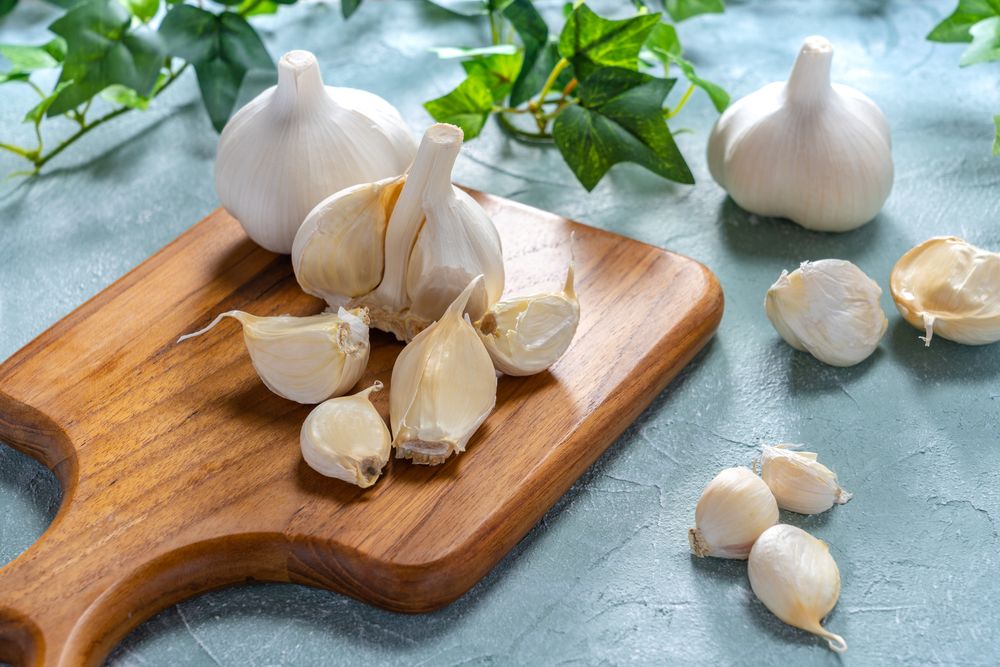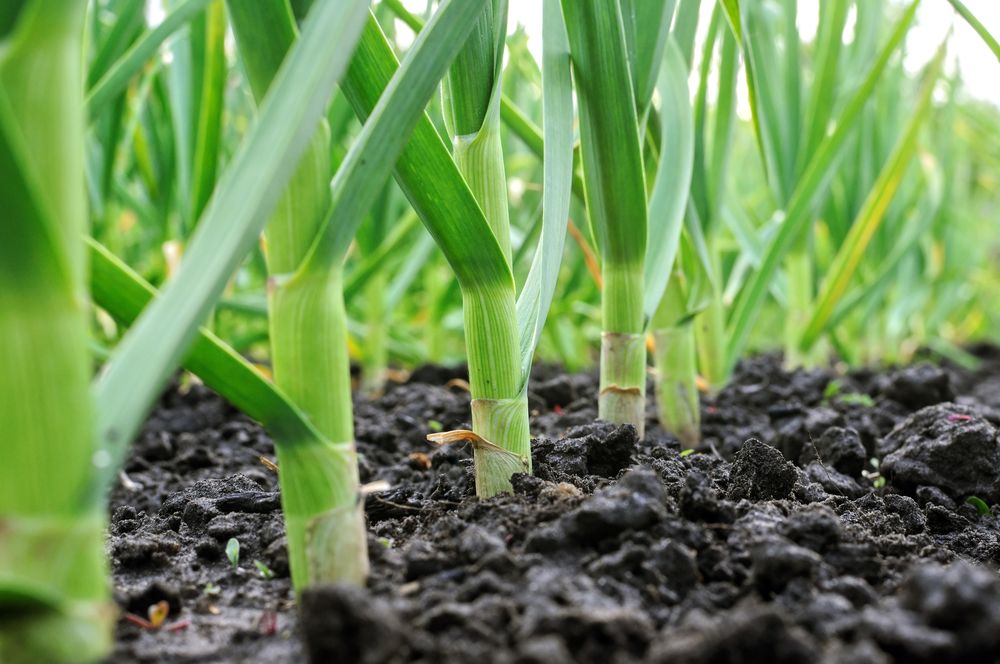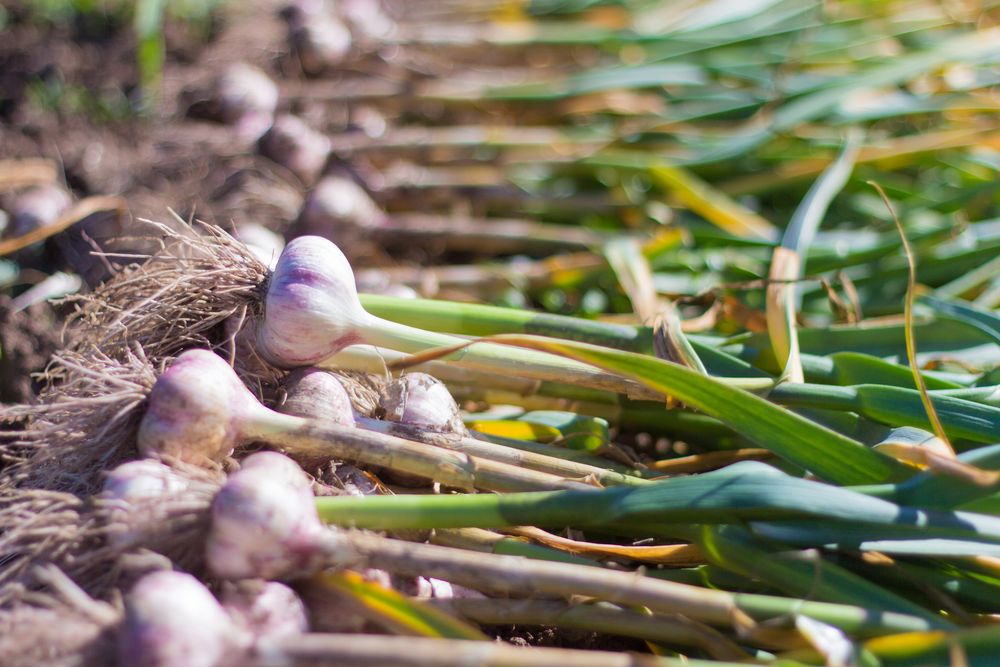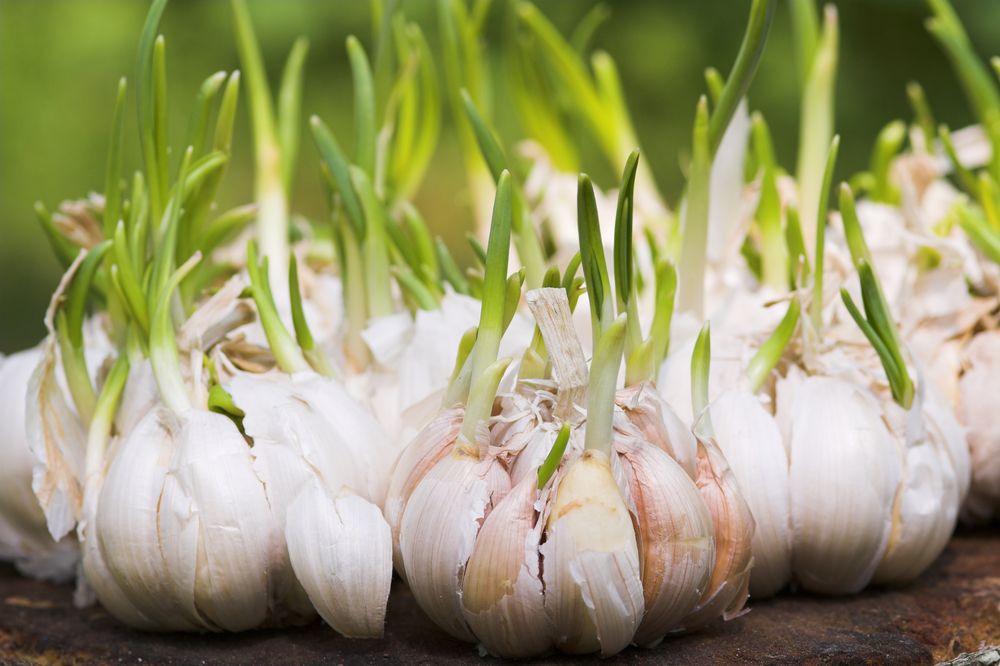6 Garlic Growing Problems And The Best Solutions For Them
Although garlic is a natural pest repellent and keeps wildlife off your veggie patch, it has some growing problems of its own. Ironically, most of those problems are related to the growing conditions around the plants. That’s not to say that pests and diseases don’t wreak havoc with garlic, because they do.
But when you have your garlic drooping, flowering, or not forming cloves as they should, then you need to look closely at how you take care of the plant and what kind of fertilizer you use. In some cases, you’d have more than one reason for the sorry state the garlic is in.
Then you’d have to fix each and every one of those possible causes before the plant can go back to normal again. But, hey, that’s part and parcel of what gardening is all about. So let’s take a look at 6 of the top garlic growing problems and how you can remedy them.
My Garlic Is Flowering
Like most veggies, when the garlic starts to flower, you know that your harvest is as good as over. Garlic plants are not supposed to flower because that means that the plant will focus on the flowers and seeds instead of on developing larger cloves.
But sometimes flowering garlic can be a blessing. Especially if you’re planting ornamental garlic varieties for the sole purpose of producing blooms. The flowers grow on top of a thick and long stalk called scapes. And these parts of the plant are delicious especially when you saute them in olive oil with some mushrooms.
Other than that, your garlic flowering usually is not a good sign and it means you need to brush up on your garlic growing skills to prevent that from happening.
How to Fix It
It often happens when the weather warms up suddenly that the garlic plant will start blooming. However, between the scapes developing and the flowers fully opening, you have a small window that you can take advantage of to save the harvest.
Before the flowers blossom, cut off the scapes. That way the plant will continue to direct its resources toward developing cloves. As for the scapes, you can cook them.
Some experts recommend mulching around the garlic rows to cool down the soil temperature and prevent the plants from going to seed early in the season. However, the benefits of that solution are limited at best. Because it’s the air temperature that triggers the development of the scapes, not how hot the soil is. That said, garlic, like many other veggies, would benefit from mulching as long as you don’t let the mulch touch the stalks.
Growing Garlic From Bulbils
Propagating garlic can be done in many ways. The easiest way to start it is to plant the cloves in the soil in the spring if you’re growing soft neck garlic or in the fall for hard neck garlic types. The cloves have a high germination success rate.
But some people prefer to grow garlic from bulbils. So what are bulbils and why is it a better way to start garlic in your garden? Bulbils only develop in hard neck garlic scapes. Since the flowers have no reproductive organs, little bulbs appear on the scapes and can be used to start a whole new plant.
Some garlic varieties produce plenty of bulbils to fill up the garden, while others have only a few bulbils. The idea is to harvest those bulbils and plant them in the fall.
How to Fix It
There are two steps involved in growing garlic from bulbils. The first is to harvest the bulbils at the right time, and the next step is to plant them.
- Harvesting Bulbils: You’ll have to wait for the bulbils to mature on the scape and burst open before you can collect them. If you harvest the bulbils before their time, they won’t grow in the soil. You will need to cut the scape after the bulbils burst and hang them to dry. When they’re fully dry, the bulbils are easy to collect by simply rubbing them off the scape.
- Planting Bulbils: The best time to plant bulbils is in the fall. Make sure the soil is loamy or sandy to avoid having deformed cloves. Test the soil pH and amend it to bring it up between 6.0 and 8.0. Sow the bulbils one inch deep into the soil and space them 6 inches apart. Keep the soil moist until the bulbils sprout. You should have cloves by next summer.
Planting Garlic With Tomatoes
We already mentioned that garlic is a natural pest repellent. If the pests don’t have a deep dislike for garlic, the strong odor will at least confuse them and divert them for your precious veggie patch. But not all plants can grow with garlic.
Sometimes the odor of the garlic would ruin the taste and flavors of the fruit or veggie you grow in close proximity to the garlic patch. This is why you should never grow garlic as a companion plant to strawberries, beans, peas, or cabbage.
But what about garlic and tomatoes? Those two get along famously and it’s no secret that Native Americans planted garlic with tomatoes all the time for the symbiotic relationship those two veggies developed.
How to Fix It
It was also Native Americans who discovered the Three Sisters method. This refers to planting pole beans, corn, and squash together. The beans fix the nitrogen in the soil for the corn while the squash climbs on the sturdy corn stalks. This intercropping is a way to take advantage of every inch of your garden and increase your yield.
So when it comes to tomatoes and garlic, the first veggie seems to get the most out of this relationship. Benefiting from the garlic’s infamous natural odors, tomatoes can grow in peace. That way you will avoid having to deal with such pests as root maggots, Japanese beetles, carrot root flies, codling moths, aphids, and borers.
If for some reason you cannot plant garlic in the garden with the tomatoes (such as you don’t like the smell of garlic) you can still benefit from garlic spray. Crush 4 garlic cloves and soak them in lukewarm water for 4 days. Strain the crushed garlic and fill a spray bottle with the water. Now you can spray your tomato plants with this natural pest repellent.
Garlic In Containers
Although garlic grows well in the garden, there are cases when you’d want to grow it in containers. For example, if you don’t have space in the veggie patch for garlic since the beds are packed with plants that don’t tolerate garlic. If you have strawberries or beans for instance, then you wouldn’t want garlic near them.
Garlic in containers makes it easy to grow this pungent plant without impacting the other veggies and fruits in the garden. But you’ll need to make sure you have the right container and potting mix to ensure that the garlic will grow successfully. Additionally, watering and feeding of potted garlic is a little different than caring for the plants in the garden.
How to Fix It
Follow these simple steps to get your garlic going in the container.
- Container: Make sure that the container is wide enough to allow 6 inches of space between each garlic plant. As for depth, it should be at least 6 inches deep to accommodate the root system of the garlic. The container should have drainage holes at the bottom.
- Potting Mix: Don’t use regular soil from the garden. Instead, make your own potting mix that contains perlite, peat, sand, and compost. It should be loose enough to drain well but not get too dry fast. Fill the container halfway with the potting mix then add a balanced fertilizer and mix well.
- Planting: Plant the cloves in the soil so that the pointy end is up and most of the clove is buried in the soil. Cover with more potting mix and firm it.
- Watering: Water the container until the potting mix is damp. Keep it moist until the cloves sprout.
- Mulching: Cover the container with a thin layer of mulch to keep the soil moist as the temperature soars.
- Harvesting: In June the cloves of garlic are ready to harvest. Dig them up and dispose of the potting mix.
Garlic Cloves Not Forming
Although garlic and onion belong to the same family, the first has cloves while the latter has layers. But once in a while, your garlic will pretend to be onions, and instead of forming cloves, you’ll end up with a bulb. What happened here?
As a cool-season plant, garlic needs low temperature to form the cloves. This temperature has to be less than 50 degrees F for about 30 consecutive nights. Another thing that garlic needs to form cloves is time. You’ll have to be patient and allow the plant to develop and mature at its own slow pace.
If you can’t tell if the garlic has cloves and is ready to harvest or not, pull up one and check it. If it still has no cloves, give the rest of the plants more time.
But sometimes other factors prevent garlic from forming cloves. Pests such as nematodes and onion thrips are at the top of the list. So what can you do about those issues?
How to Fix It
First and foremost, you need to choose a garlic variety that suits your hardiness zone or microclimate. If you live in a warm zone, then selecting a variety with a high tolerance for warm weather will ensure that your garlic will form cloves even if the temperature doesn’t cool down at night.
If the weather gets too extreme without warning, then consider growing garlic in containers and bringing it indoors to protect it.
Nematodes suck the sap of the leaves causing them to turn yellow. They also infect the bulbs and cause deformities. The best way to get rid of nematodes is to solarize the soil by covering it with sheets of plastic and letting the sun bake the soil for two weeks.
As for onion thrips, you can tell by the white spots on the leaves that you have a thrip infestation. Spray the plants with neem oil to kill the onion thrips. You’ll need more than one application to fully eliminate the pests.
Finally, be patient and allow the garlic to develop. It takes the plant up to 240 days from the time you plant it before it’s ready to harvest.
Drooping Garlic Plants
Garlic is hardly the top-heavy plant that would keel over. So why do garlic plants droop or fall over each other sometimes? There are many reasons for that and some of them are quite harmless.
The first reason is that the plant is nearing harvest time. The leaves wither and turn brown then droop over the plant. That’s your cue to get ready to harvest your cloves.
Other reasons have to do with drought, poor soil, insects, and lack of sunlight. Those are the reasons that require your intervention.
How to Fix It
Start by making sure that the garlic is getting at least 6 hours of sunlight every day during the spring and summer. If it’s not, then you’ll need to move the pots to a sunnier spot.
Check the soil to see if it’s too dry. Drought causes the leaves to droop. Water the plant enough to get the soil moist.
Test the soil and make sure it has the four crucial elements, nitrogen, calcium, potassium, and magnesium. Use plant food supplements to nurture the plant back to health.
Wireworms cause the leaves to droop. Cut a potato in half and bury the halves in the soil near the garlic for a day or two. The potatoes attract the wireworms so when you dig up the potatoes you’ll clean the soil from those pests.



